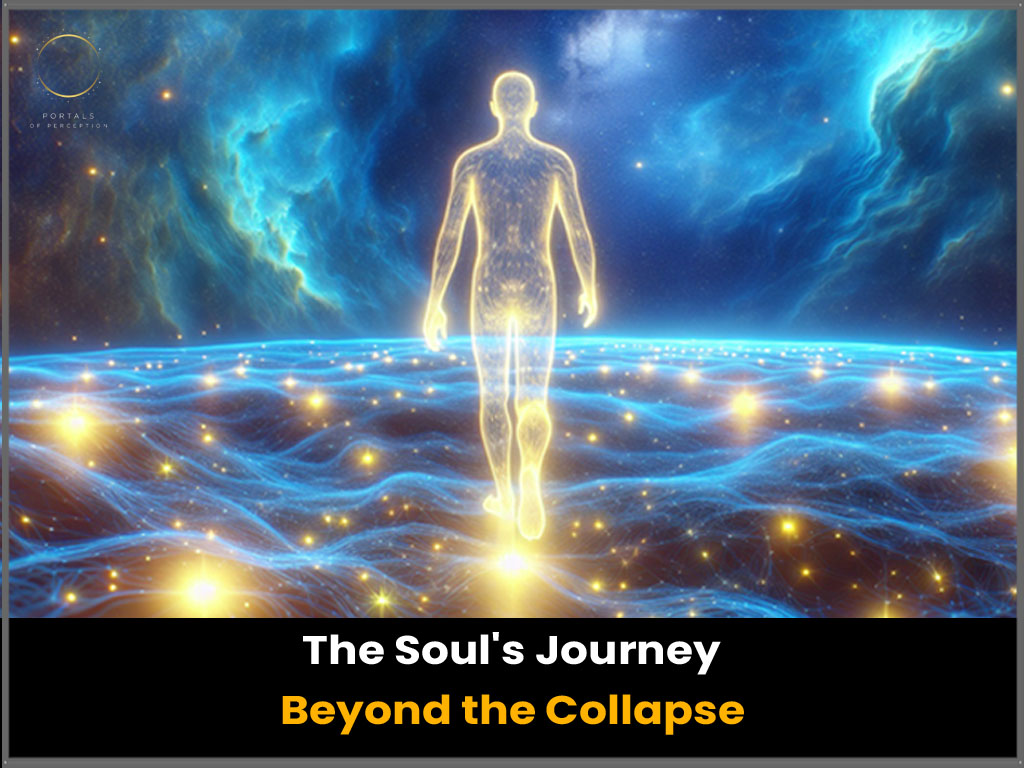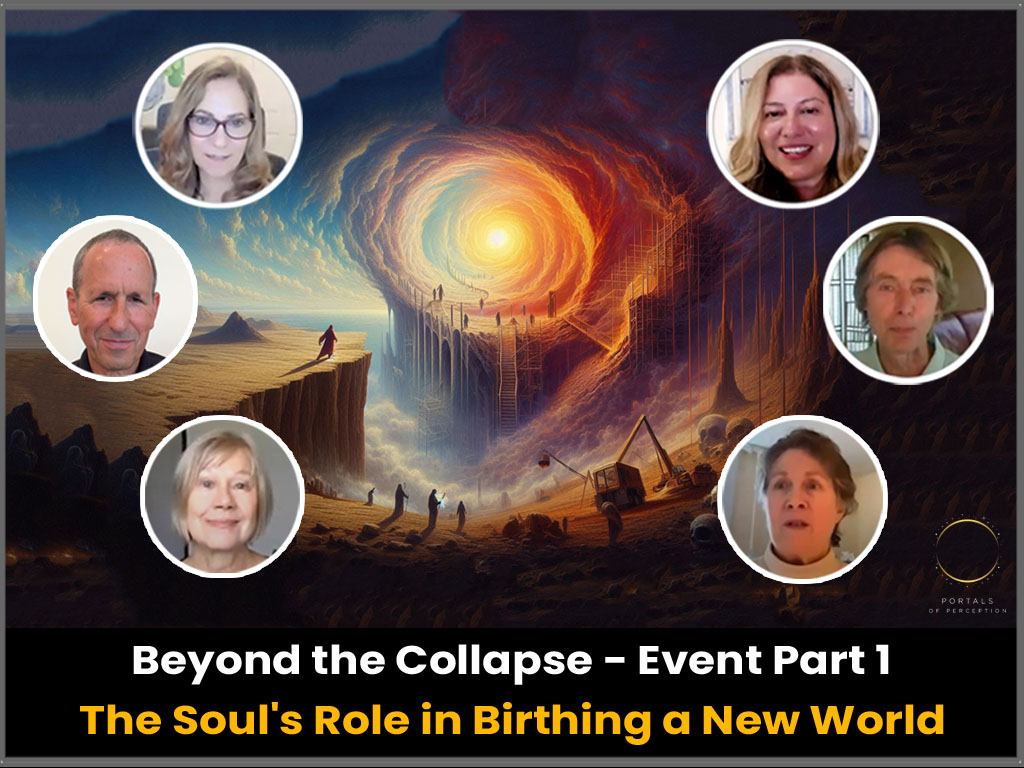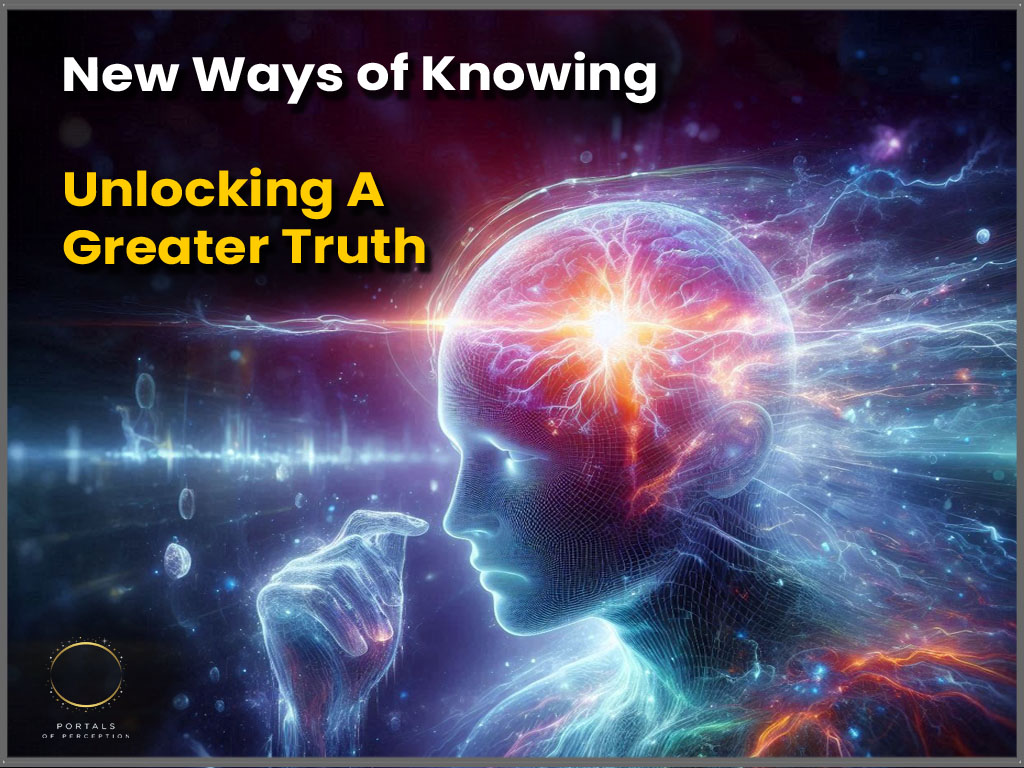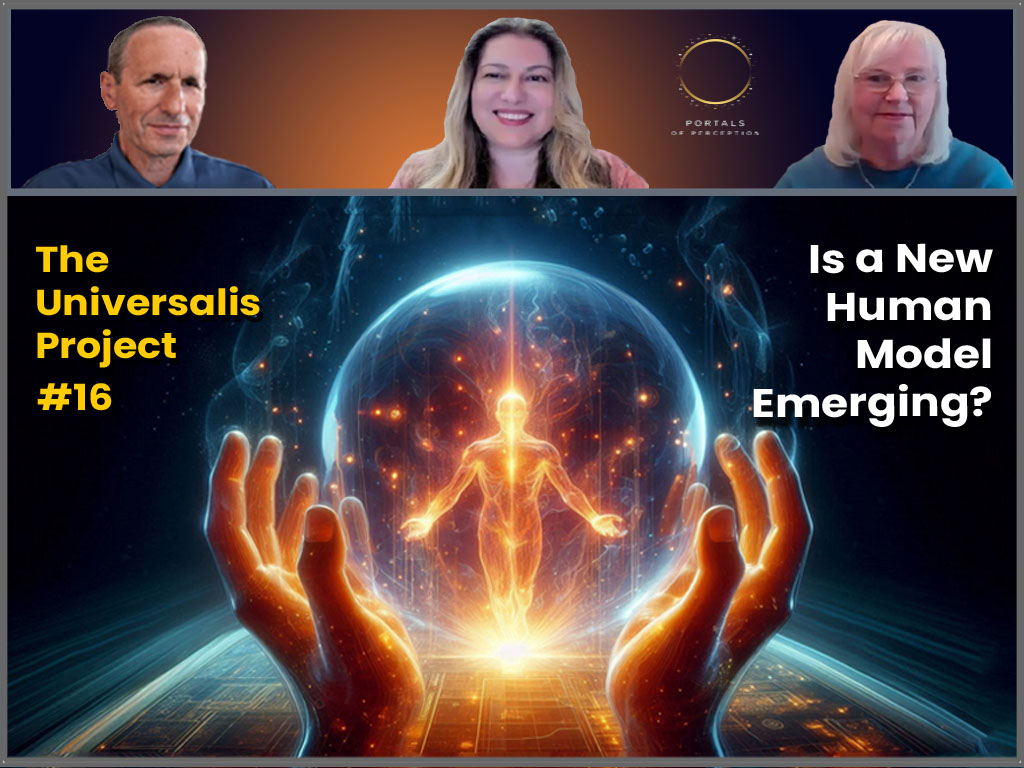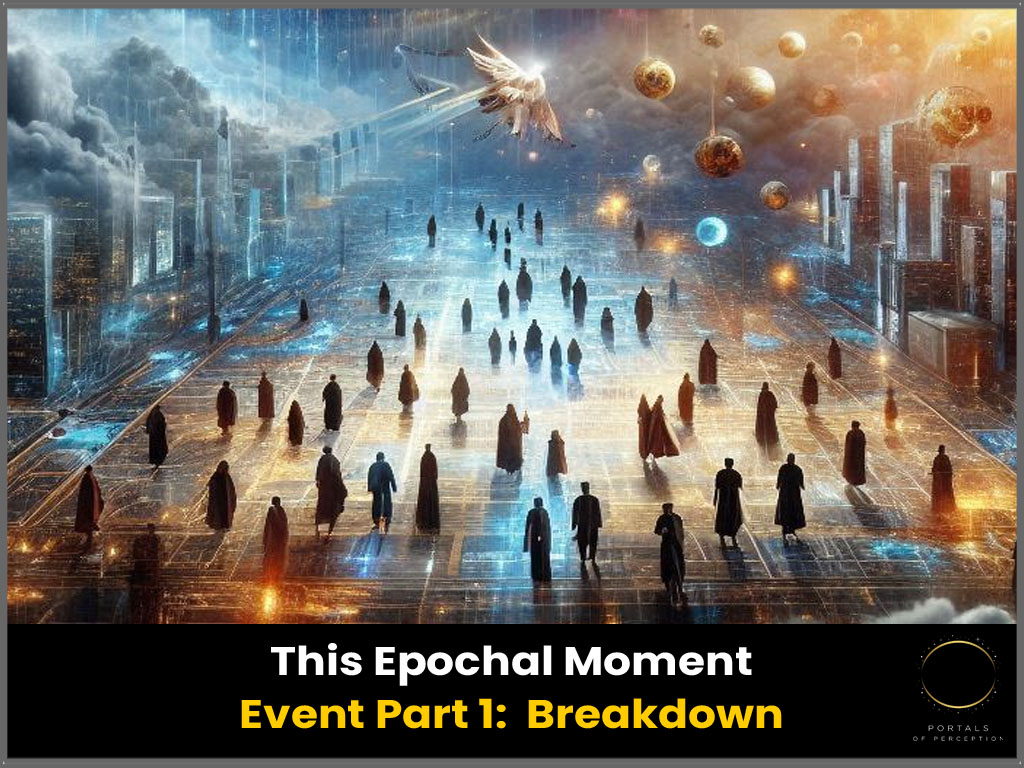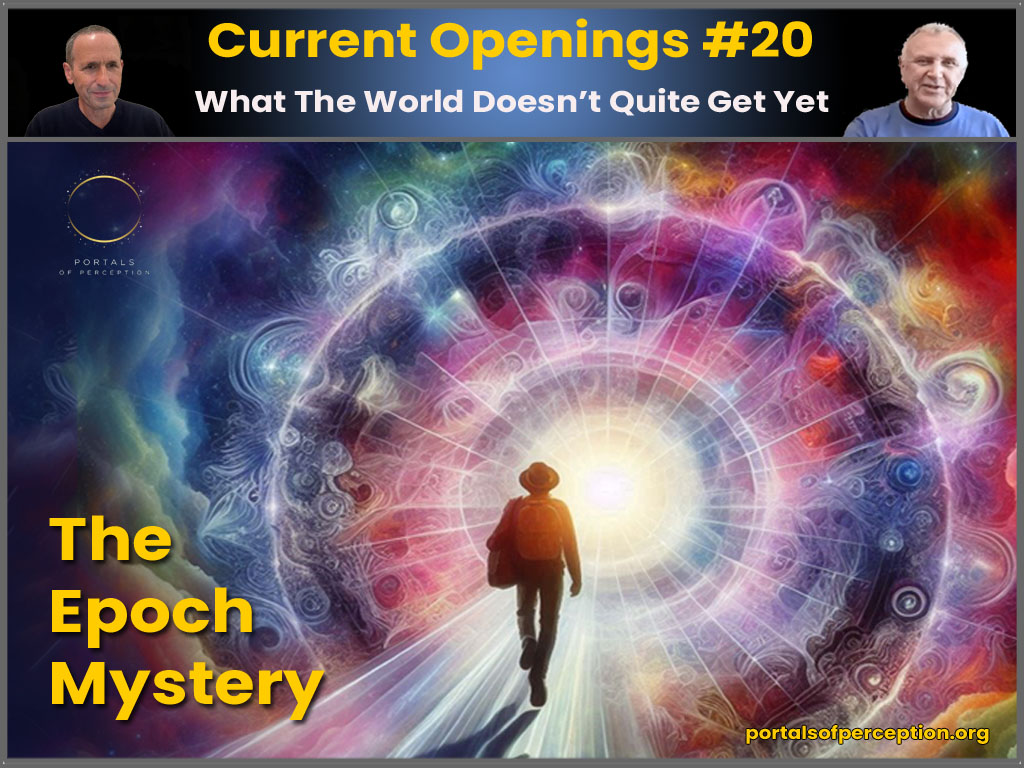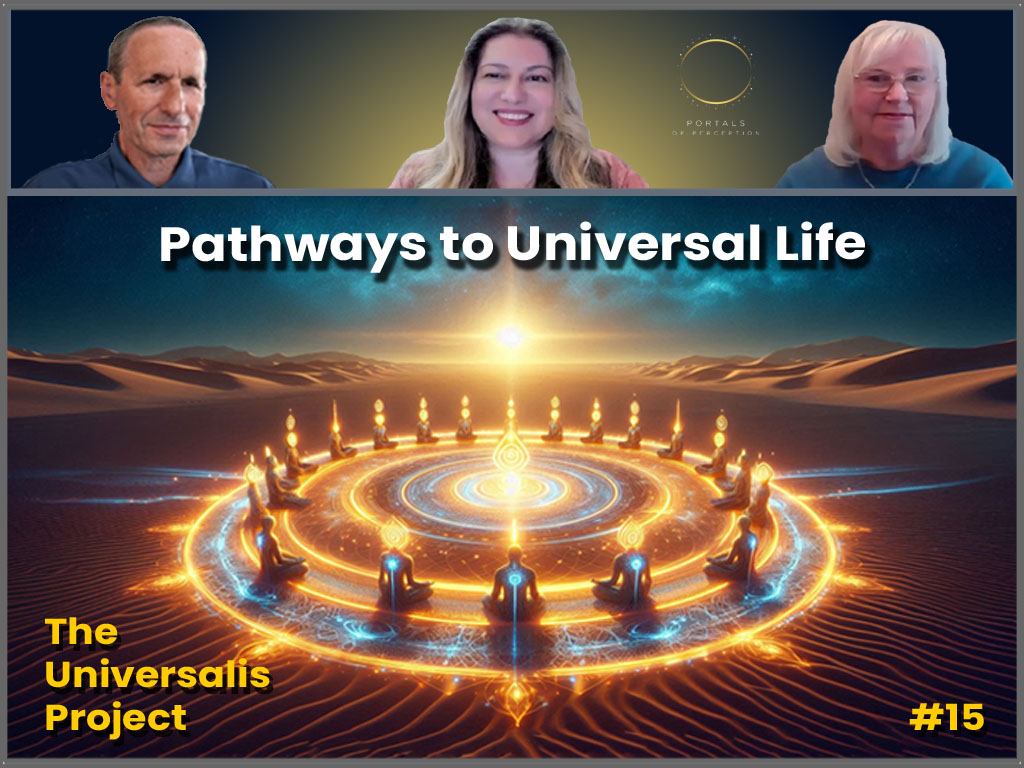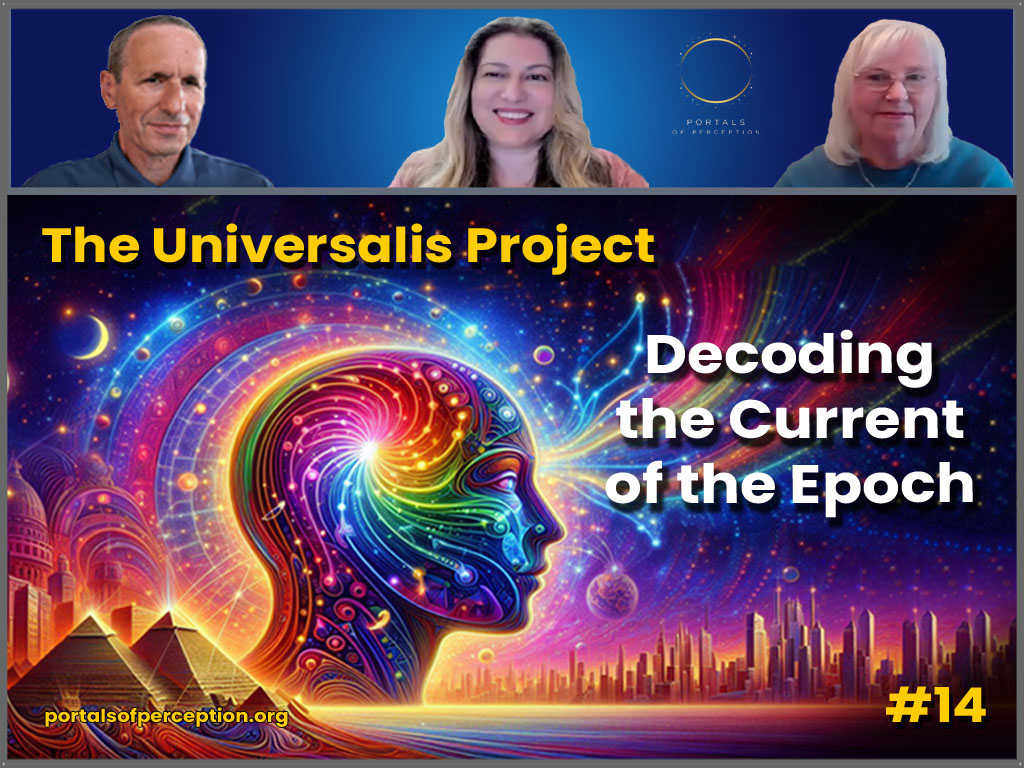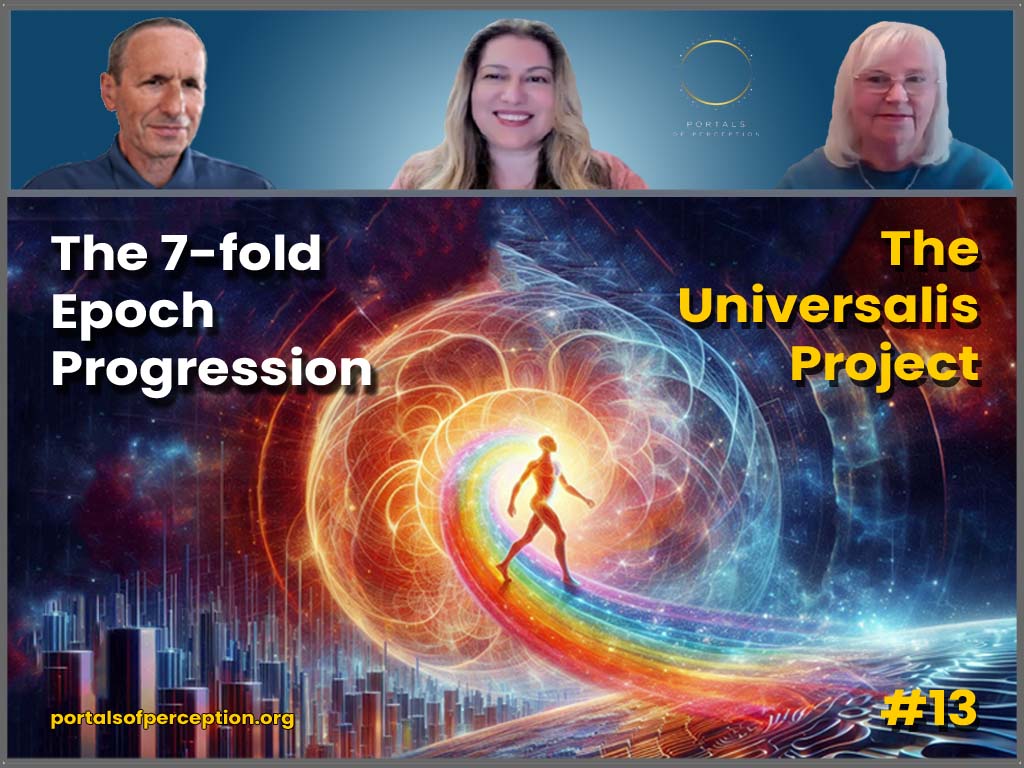In the third installment we described two ways to apply Einstein’s admonition when he observed that we cannot solve our problems with the same thinking we used when we created them. The first practice involved placing the problem you are working to solve inside an even bigger problem. The second practice involved the cultivation of a symphonic loom of expanded considerations.
The realization latent in this admonishment from Uncle Albert is that we cannot expect to stumble on new perceptions with the same toolset we used to fashion the map of meaning that generated the problems we now confront.
Moreover, the faculties and “organs” of seeing, intuiting, and believing used when we generated our worldview are likely insufficient in our search for new ways of perceiving with which to be able to solve the problems we face.
In this and in the following installments we are embarking on the search for ways to unlock new perceptions, connections, and intuitions. We seek the activation of sense organs that naturally court and grow the spaces available for the soul to liberate. We will develop this pathway one step at a time and invite you to engage and play with the practices we demonstrate.
Weaving a Loom of Possibility
To develop our odyssey and find a new vantage point with novel ways of thinking and perceiving to approach the double anguish of the soul and its compensatory act, the ghost, we began creating a loom of soul considerations.
To sample working with a loom, consider the following visual. In the upper left space of our loom, I write: The soul — a companion for the spirit, acting as an orchestration and navigation liaison, facilitating the planetary experience in a human model.
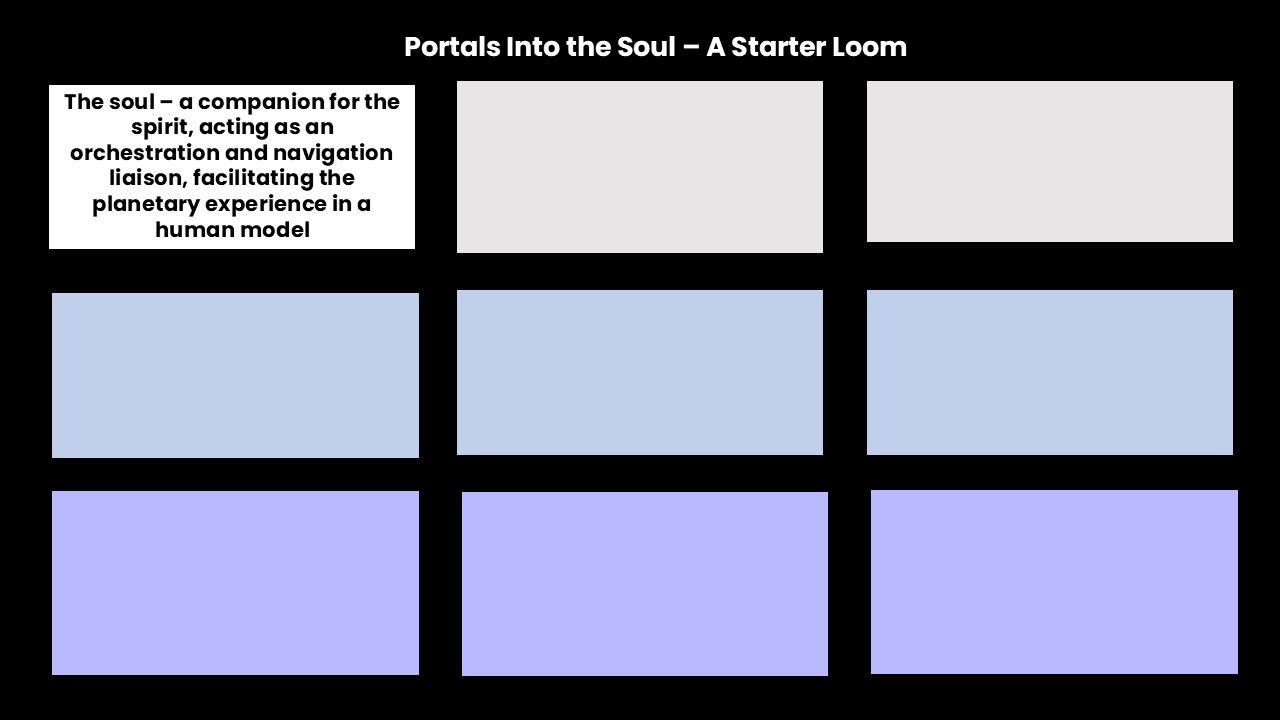
To the right of it in the middle space, I write: The soul’s three-fold brief: the guardian of life; the steward of learning; the champion of higher purpose.
In the third space to the right, I include: A person’s unique soul configuration of qualities and essences can be experienced in blissful moments of becoming fully alive.

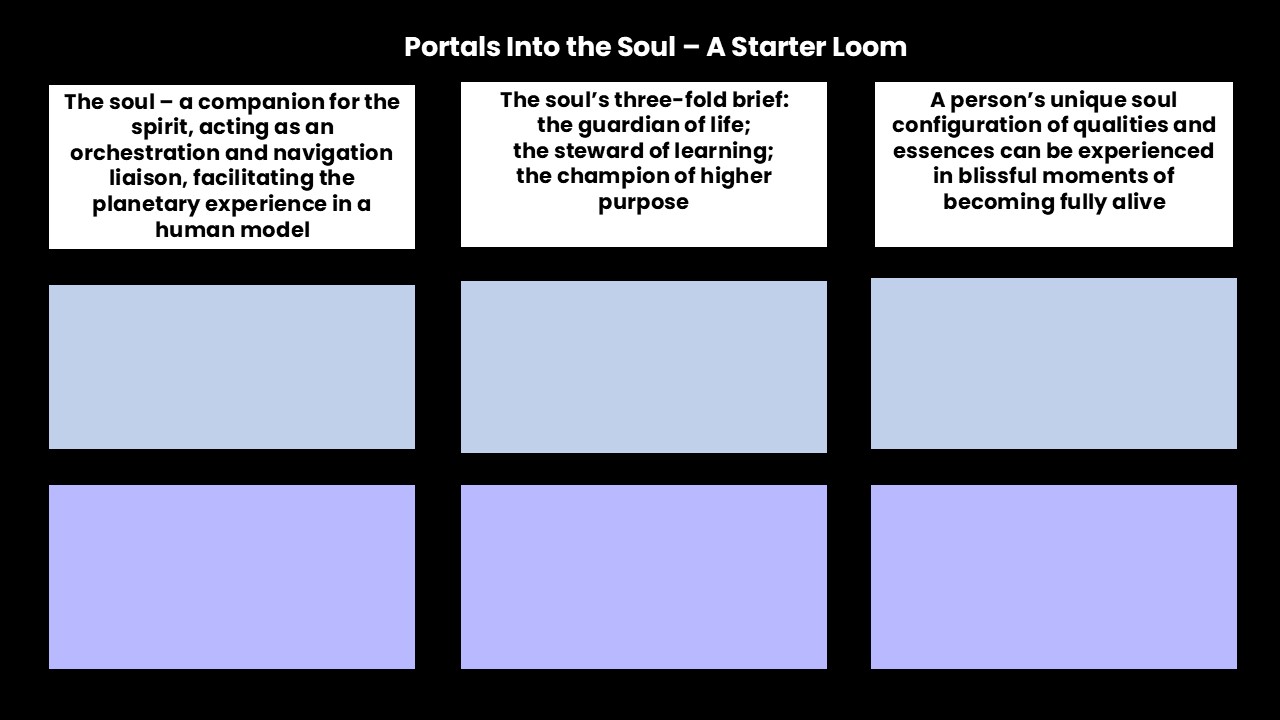
I am demonstrating the process of contemplative distillation from chapter one. I describe these as contemplative distillations because they are not framed as end-stop definitions. Instead, they each represent a discovery trailhead. You are welcome to create your own contemplative loom to harvest and codify your contemplative discoveries. They can include insights and inquiries you want to abide with and develop.
There is a fundamental orientation shift in this approach. Most people, speaking about most topics, look to assert a point of view as an end-stop fact. Actually, a large part of what is considered as modern education is made of restating what has already been said. The accent of the entire pursuit of knowledge seems often to intimate the desire to gain purchase and control of the world. The loom process I am demonstrating aims to engender a reverse move.
In chapter 2, we contemplated the universe waiting to be born out of its 95% latent potential. In the loom work approach we do not focus on the five percent that has condensed into matter from the universe of potential, where we may be able to have the illusion of control. Instead, we seek to engage the sixth and seventh percent in the liminality of what we do not know. That’s the reverse move.
Let us now integrate chapter two into the loom. In the second row to the left I write: A universe waiting to be born: Could the 95% of the unknown universe be waiting for us to get on with our own development and evolution?
In the middle space of the row: Separation events and the double anguish of the soul. In the third space to the right: The compensatory act of the soul — the ghost.
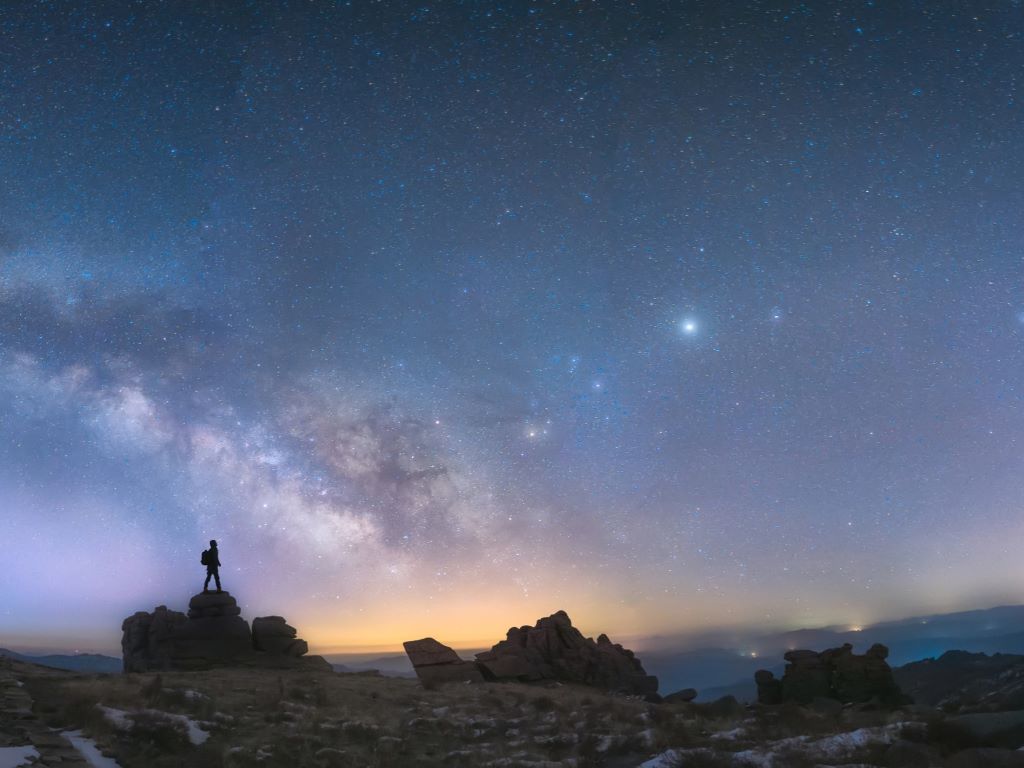
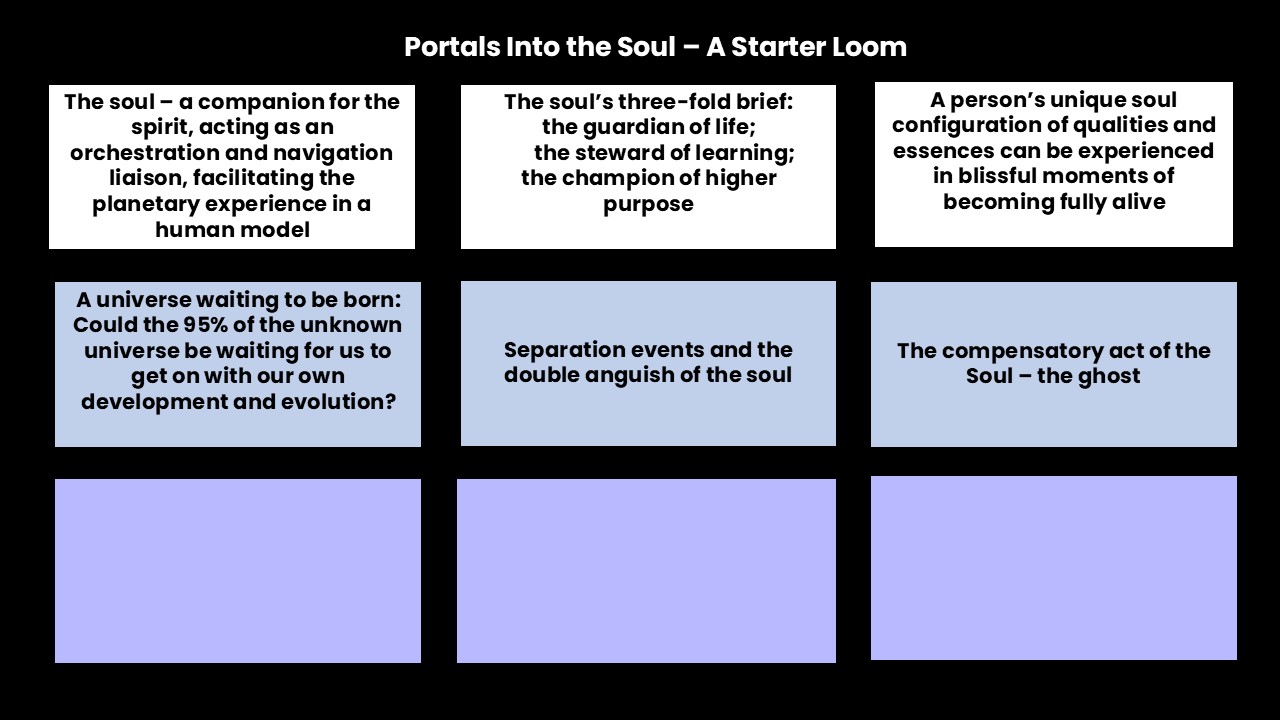
Each of those spaces contains a lifelong contemplative inquiry leading to potential discoveries and prospective revelations. This is the way of non-linear contemplative inquiry. You can go deep into each of the spaces and cultivate the potential inquiries latent inside each. In parallel, you can develop the inquiries that emerge in the relationship of each space to the other spaces.
Just one example is in bringing together the two spaces in the left column: The soul — a companion for the spirit, acting as an orchestration and navigation liaison, facilitating the planetary experience in a human model; together with A universe waiting to be born: Could the 95% of the unknown universe be waiting for us to get on with our own development and evolution?
There are several contemplative inquiries that naturally arise in this combination:
- Inquiry 1: What enables the soul to serve as a navigation liaison in a universe that’s 95% unknown?
- Inquiry 2: If our personal and collective development and evolution are how the Universe gets to know more of itself, what requirements are etched into the human model and its orchestrator, the soul, to facilitate this process?
This is a minimalistic sample. The potential is vast because I approach these inquiries not merely as philosophical summersaults. Instead, I listen to these configurational possibilities in the whole of my system, not just my head. I listen to my feelings, intuitions, and I listen to my soul listening to these formulations.
Remember I asked you in the preamble to not believe anything I say just because I said it. I invited you to endeavor to discover what you can validate for you. Instead of this voyage centering on the discoveries I impart, I am asking you to center on revelations you feel ready to find inside you.
I will describe my path into these mysteries in a later installment. For now, let me simply offer that my way with such contemplations has been to hold them as permanent line inquiries. There are questions I’d hold active for months and some for many years.
Two more inquiries to weave and develop in this way of growing and expanding space for the soul are:
- Inquiry 3: Why and how to contemplate?
- Inquiry 4: In seeking to liberate the soul from the predicament of its double anguish and the fixation of the ghost, what could the function and relationship be in developing the art of somatically-guided inquiry?
You might be wondering what it even means to hold inquiries about the soul and the spirit for years. Well, chapter three seeded this with a starter appreciation of two different processes — one where the brain governs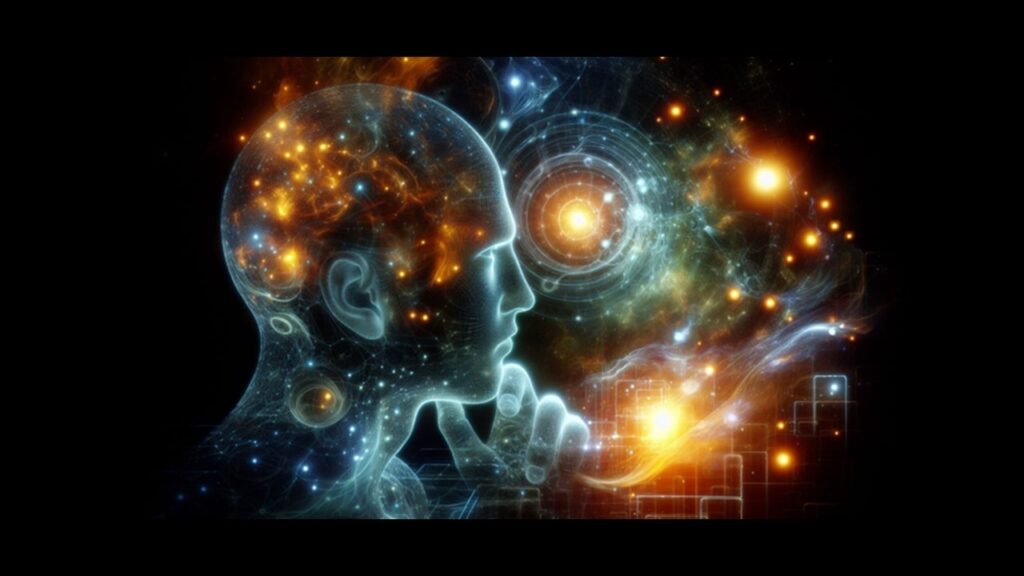 our attentional process, and the other where the mind leads the brain.
our attentional process, and the other where the mind leads the brain.
The evolutionary wiring in the brain, which acts on the first soul impulse to keep us alive, is vigilantly alert to identify any threat and danger. It is this early wiring in the brain that continually engenders alert signals that provoke short-wave disjointed reactions, thoughts, and worries. It is not easy to contemplatively dwell with permanent line inquiries when the soul is unsettled and nudges you to address unmet survival needs.
Facilitating settlement and calmness with the guardian of life (the first nature of the soul) is vital to calming these alert signals and to releasing compulsive preoccupation with anxious vigilance in the brain. As earlier survival wiring in the brain is pacified and calmed, the mind can begin to lead our attentional focus, facilitating and expressing the two higher natures of the soul in the process.
Liberating the natural curiosity and discovery power of the steward of learning (the second nature of the soul) and freeing the connective communion capacity of the champion of higher purpose (the third nature of the soul) release and activate energy through circuitries that overlay the early brain wiring. They also enable the higher system to superimpose short-wave disjointed thoughts with long-wave permanent line contemplations.
This is an alternative path to the Eastern practices of mindfulness. We don’t seek to empty the mind by releasing identification with passing thoughts as a way of calming the survival wiring in the brain. Instead, this work into the soul invites you to free the mind to its connective communion capacity, where it brings to the soul potent energies to nourish its two higher natures. In this work, the communion itself unlocks the energies and biochemistry to pacify and regulate hyper-vigilance in the brain.
The natural capacities of the mind are long wave, whole-picture and symphonic, and can foster vast and far-reaching connective communions. We use loom work to ease this shift from brain preoccupation to mind connection, in service of these higher natures of the soul.
Let us now add to this loom of pathways into the soul the distillation points from the third installment. In the left space of the bottom row, I include: The Einstein brief: we cannot solve our problems with the same thinking we used to create them.
In the middle space: The symphonic loom orchestration process and its multiple applications. In the space to the right: The seven-fold natures governing living processes and the soul calibration and orchestration knowhow.
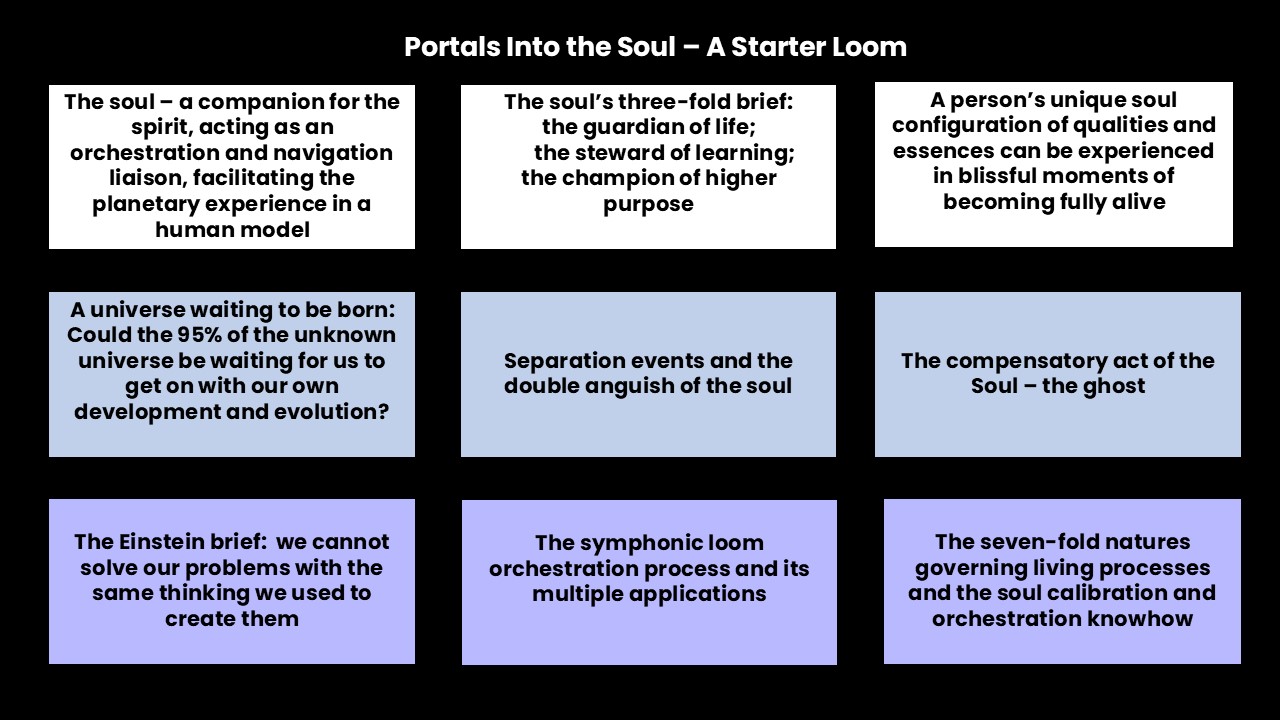
This is one way to apply and play with loom work. It is not formulaic. You are welcome to weave and integrate your own discoveries and artistic creativity. I invite you to find your own symphonic pathways into the soul.
We are using loom work to court possibilities by cultivating intensifying conductivity in your process, which you facilitate by creatively connecting those adjacent spaces. You are welcome to integrate into it more than words only. For some it works best by cultivating these spaces with drawings, or by naming unique qualities in each of the spaces, or by composing a melody for each, or through somatic practice and dance, and/or any other media that becomes conductive for you.
To help us release the predicaments and the gravitational hold of the conditioned line, where the soul is held back or even frozen from its fuller range, we are seeking to engender ease and flow. How do we facilitate ease and flow?
 We prod the liminal space outside of what we think we already know, seeking to loosen the grip of arresting definitions.
We prod the liminal space outside of what we think we already know, seeking to loosen the grip of arresting definitions.
These portals into the soul installments are deliberately fashioned as an evolving loom, with open spaces and spaces between spaces. We are not teaching a new dogma. Instead, we seek to activate this immense kaleidoscope of possibilities, where there are a million and one ways.
I described in the third installment my experience of getting lost while navigating on a dark night. I used this experience to ask if humanity has lost touch with the terrain of what being human is.
Have we arrived in a place where we can no longer recognize who we humans are? Curiously, we are now seeking to be lost, again, but for a different reason.
In my navigation I needed to get to a specific point and got lost on the way to it. The reverse move is that we have found the proverbial point of sophisticated modern living, only to discover we are increasingly separated from the natural bliss of the soul. Instead of young people discovering their soul possibilities, for the first time in modern history an increasingly growing percentage of young people are anxious, depressed, and even suicidal. This, too, is a symptom of the Violet culmination of the epoch.
One way it expresses itself is the alarming upsurge in the time spent in front of screens, especially among Gen Zers, the Millennials and Gen Xers, where sophisticated algorithms hijack their attention. In the seven-fold process, Violet unlocks phase-shift transformation. Decay, breakdown, death, and rebirth, transformation, and emergence, are all integral to the Violet function.
Consider this Koan: We are lost because of what we have found. To find ourselves anew, we first need to lose the conventional thinking we have found. We need to be lost to the limiting definitions of the thinking that created the predicaments we are in.
We cannot find the sixth percent of our latent universe inside the arrested definitions of the five percent we already know. Soon we will also ask, can we lose the lies we have internalized about who we are?
This is a courting process. We are courting dynamic new possibilities to emerge in the interior and in the world at large.
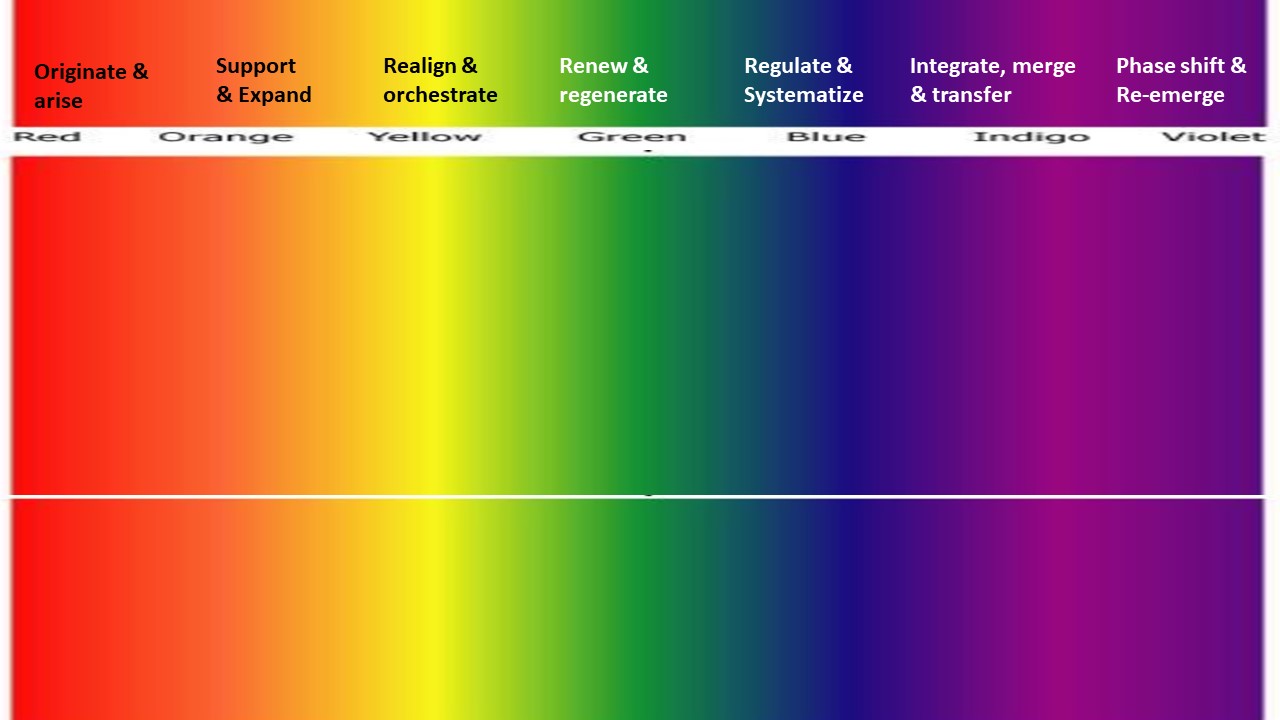
The Post-Ideological Transition
As we develop these conversation pathways into the soul, naturally, we confront several challenges. A key challenge is finding the courage to drop the lies we have been told about what a human is. There is a catch. How do you let go of misleading lies you have been programmed to believe in, without having new or elevated or clearer perspectives that can replace those convictions and beliefs?
How do you update your map and find a way to connect with reality, one that includes a soul, all while the terrain is shape-shifting?
These are important questions as we seek to find portals into the soul.
Here is another question I hold in my contemplations. What capacities will afford a person the courage to question, sense, intuit, and discern for themselves? How can we help ourselves relax into reintegrating and embracing intuitive ways of knowing?
One reason we cultivate the art and science of contemplation is to help liberate latent human capacities. We cannot unshackle suppressed capacities by trying to reconstitute an outdated map. This again is the Einstein brief. In times of upheaval and change, instead of fear-induced search to find stability in reconstituting an outdated map that no longer works, we need to let go of the map and find an inner stability, all while we assimilate a new shape-shifting map.
This pivot to finding calmness, stability, and peace inside you, rather than expecting to find it outside in a shape-shifting world around you, becomes an imperative in what we describe as the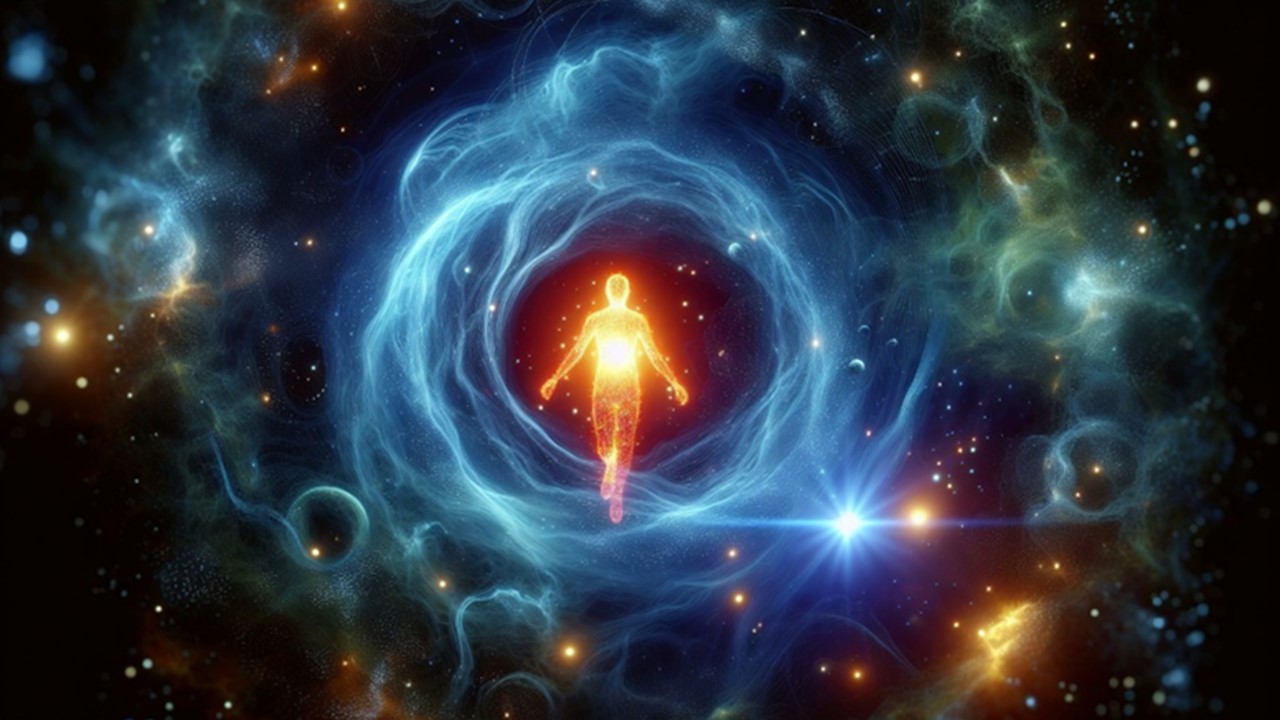 Indigo-Violet shape-shifting phase of the epoch, which is now culminating.
Indigo-Violet shape-shifting phase of the epoch, which is now culminating.
The terrain is continuously changing. It is both challenging and also filled with promise. We have entered a post-ideological age. Ideologies took center stage after the American and the French revolutions in the late 18th century. They represented systems of beliefs and attitudes that shaped socio-political life, governed perception and values, and guided behavior and action.
In the seven-fold epoch story, ideologies rose to prominence along with the ascent of the modern project, as part of the Blue fractal of the epoch progression. The Indigo and Violet transitions in the late 20th century represented the onset of the post-ideological age.
Along with the evolutionary potential Indigo and Violet unleashed, they potentized a technologically enabled socio-political fracturing that also catalyzed regressive moves as expressed in the resurgence of tribalism and the breakdown of civil order. Regressive cycles additionally represent opportunities for healing, development, and reintegration; that is, if they do not unleash cataclysmic destruction.
The Indigo-Violet epoch culmination is the bigger context inside of which we are searching for portals into the soul. Post-ideological developments are an element in this, leading humanity to be swimming in a stormy ocean of confusion and noise, where traditional architectures of knowledge, truth, meaning, and morality have disintegrated. We are facing a transitional struggle filled with possibility of renewal, reconnection, and elevation, mixed with pain, confusion, grief, and despair. Our guiding premise is that in this transition, the rediscovery of the soul is essential.
In the ideological 20th century, it was easier to think you knew right from wrong. That sense of a global shared reality has largely evaporated. Perhaps it was a temporary veneer, produced by those who were meant to know. The modernity project, its institutions of knowledge and the pillars of authority and stability, continue now to unravel.
While fundamentalist ideologies persist in many forms, most of the large persuasive ideologies of the 20th century were left by the wayside. The disastrous carnage they’ve brought became obvious and humanity has been struggling to evolve beyond them for several decades.
The Grandeur of Science and its Shadows
Two ideologies that remain standing and joined at the hip to reign supreme are the growth-forced capitalist paradigm and materialistic reductionist scientism. These beliefs and convictions are insidiously pervasive in shaping how we have seen ourselves in recent centuries.
The chief reason why these joint ideologies are so pervasive is because they have been so wonderfully successful. Having replaced traditional religious meaning structures, they constituted a world view and narrative that asserted man’s triumph over nature. They shaped a belief in man’s ability to control the world and brought for a while tremendous prosperity, peace, and other forms of goodness we cherish, including a life of convenience. As the 21st century arrived they began to show early cracks. The modern world still offers comfort and relative stability in many places, but it is getting undone by the bugs in its operating system and the problems it created.
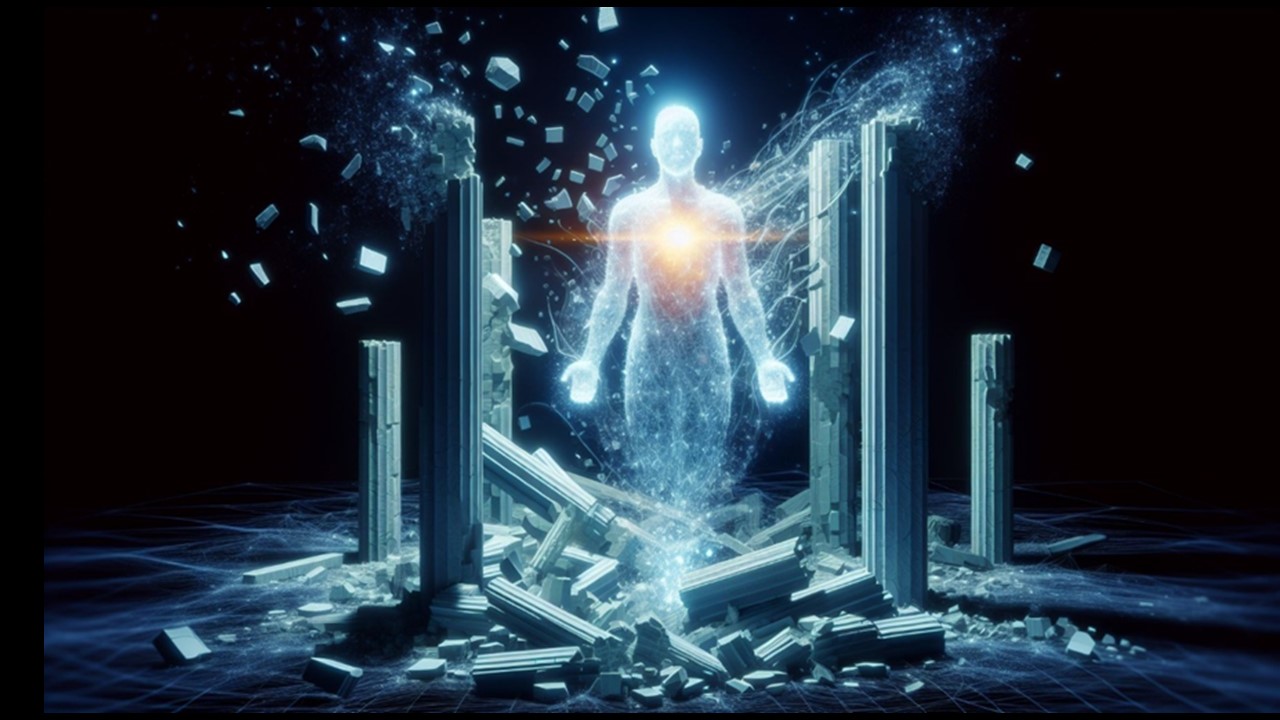 Why has the moment of shared peace and prosperity of the late 20th century been crumbling? Where is the problem?
Why has the moment of shared peace and prosperity of the late 20th century been crumbling? Where is the problem?
Let us develop a loom of awareness in approaching these inquiries. To be clear, there is a difference between the scientific method and materialistic reductionist scientism. The scientific method unlocked profound developments and possibilities. It gave us a process to acquire and expand our knowledge. We've learned we can a) observe, b) ask a question, c) research for possible answers, d) formulate hypotheses and make predictions, e) perform an experiment to test assumptions and predictions, f) analyze data and validate, reject, and/or update theories, g) draw a conclusion, and h) apply the findings. It is a process that enabled us to begin mapping the universe and unlocking succeeding waves of technology.
Materialistic scientism is the belief that reality can only be understood through observation of a physical world that has no interior dimensions. It assumes every other pathway to appreciate the world that doesn’t begin with the physical universe to be superstitious or nonsensical. It denies the viability of a soul. It sees properties associated with consciousness to be merely a byproduct of atoms and molecules complexifying processes and asserts the mind is completely and wholly found in the organ of the brain.
Remember, every light brings its shadow. The scientific light that enabled the miracle of the modern world has been so wondrously bright that it produced several shadows, confronting humanity now.
The first shadow emerged in the economic model that captured science. What emerged as a passionate search for truth and a desire to unlock the mysteries of life and the universe — reigniting Aristotelian thought, the ancient Egyptians, Greeks, and Romans, with Francis Bacon, Copernicus, Kepler, Galileo, and Newton — was captured by the economic model through the advent of the Industrial Revolution and the technological waves that followed it.
With no alternative support models in a growing capitalist industrial society, science was co-opted and enrolled in a greed-based, extractive economy designed to drive growth. As long as the large majority were benefiting from a “rising tide lifts all boats” scenario, and humanity stayed within planetary resource boundaries, the compelling incentives were just irresistible.
The method for decoding how the world works was seized to shape the material world for profit. There is nothing wrong with profit. The economy of nature itself generates the greatest surplus, which enables life to thrive. Profit turns out to be a cancerous problem when it is an end to itself, as it becomes the first principle driver, dethroning the perennial universal values of life, goodness, truth, beauty, and wisdom.
The success of the scientific investigation in finding truth led to the corruption of its first principle inquiry, as it was co-opted and enrolled in support of commercial,  financial, and utilitarian benefits.
financial, and utilitarian benefits.
Clearly, we are observing a general system trend rather than condemning any individual. Many, perhaps the majority of scientists are truly passionate about decoding the truth of how the world works. Still, they operate in a system that has largely been captured by distorting economic incentives.
The second shadow emerged with the prestige and recognition game that captured science. The Enlightenment and its scientific impulse merged with a social change that came to do away with stifling heredity and aristocracy in favor of meritocracy. The scientific revolution led us to find what is true; it was joined by a social and economic revolution that looked to reshape what is valued. A byproduct of the socio-economic revolution was the need to fill the social void created by doing away with nobility, aristocracy, and partly royalty.
All complex ecologies give rise to functional hierarchies. Walking into the forest, you discover sophisticated food chain and emergent hierarchies in plant life and in the animal kingdom. Ancient tribal societies, medieval and then traditional societies, each expressed their value system in the way they coopted a functioning hierarchy. They organized societal structures, distributed resources and power, created gatekeepers, and elevated a chosen few above the rest. (*)
The scientific movement produced a new modern elite, supplanting the physical with mental and intellectual prowess and strength. It unleashed in the academic and the scientific community the meritocracy prestige and recognition game. It was an important and useful cornerstone and a true emblem of the modern project. We could now celebrate people for their achievement and success and lift them up to become role models for society. The Nobel Prize and other recognitions that followed became artifacts and rituals of modern societies.
(*) (Deconstructing and breaking down the various ways humans have coopted hierarchies in traditional and then in modern societies has been a central drive of postmodernity, which we map in the epoch story as an element of the Indigo melting of Blue structures.)
Again, every light tends to produce a shadow. With the economic incentives of tenured positions, the academic and scientific spheres were captured by these two currencies: the recognition and prestige of being quoted, referenced, and celebrated, and how these secured funding, research grant monies, and access to the charms and occasional grandiosity of living a privileged life.
All the way back to Newton, and through Freud and Jung, and many great pioneers in the hard sciences, we find a curious reputation management twist. They seem to be concealing their metaphysical and esoteric inquiries, fearing reputational damage that will take away from their accomplishments and legacy.
This has now become much more prevalent, as the 20th century prestige game was updated and partly supplanted by the social media popularity contest. An example is what has become almost an engrained “Free Mason”-like handshake ritual conducted in academic and scientific circles that you can watch on YouTube. Many  scientists sheepishly make brief conjectural metaphysical comments, only to then self-deprecatingly caveat these comments as though to say, we of course don’t believe any of that; it is dangerous for a real scientist to even consider matters of the soul and the spirit. This ritual and collective amnesia twitch is a symptom of what we are describing as the rigid dogma of materialistic reductionist scientism.
scientists sheepishly make brief conjectural metaphysical comments, only to then self-deprecatingly caveat these comments as though to say, we of course don’t believe any of that; it is dangerous for a real scientist to even consider matters of the soul and the spirit. This ritual and collective amnesia twitch is a symptom of what we are describing as the rigid dogma of materialistic reductionist scientism.
At a later installment we will come back to this perplexing conduct when we ask what it was that deadened our inner sensing and intuition of the soul. What are the persuading influences in the last 400 years that made us believe the lie of materialistic scientism?
The large majority of scientists genuinely follow their curiosity and increasingly find it easier now to use perhaps the second most powerful phrase in the English language: “I don’t know.” Still, there are those who would not go beyond the title Portals Into the Soul because we dare use the word soul. Some would publicly scoff at the very mention of the soul as a form of virtue-signaling superiority act, and a kind of ritualistic separation between “credible scientists” and those “playing with superstition”.
In fairness, there are good reasons for irony and occasional skepticism. Science did liberate us from hocus-pocus craziness and so much more. In the process, however, it gave rise to rigid scientism which has become as dogmatic as any of the religious dogmas science fought to liberate us from in the first place.
I anticipate our grandchildren and their grandchildren will look back at us and wonder how foolish, crude, and primitive we have been to insist on a distorting intellectual superiority by dismissing the soul, which brings us to the third shadow.
The third shadow emerged inside the scientific training, in delegating and exteriorizing our power and disenfranchising interior ways of knowing. We’ve thrown the baby out with the bath water by learning to privilege the telescope and the microscope over our inner-sense-organs-scope. We now privilege the physical world as the only world, and we give credence to exterior impressions coming through our senses to the exclusion 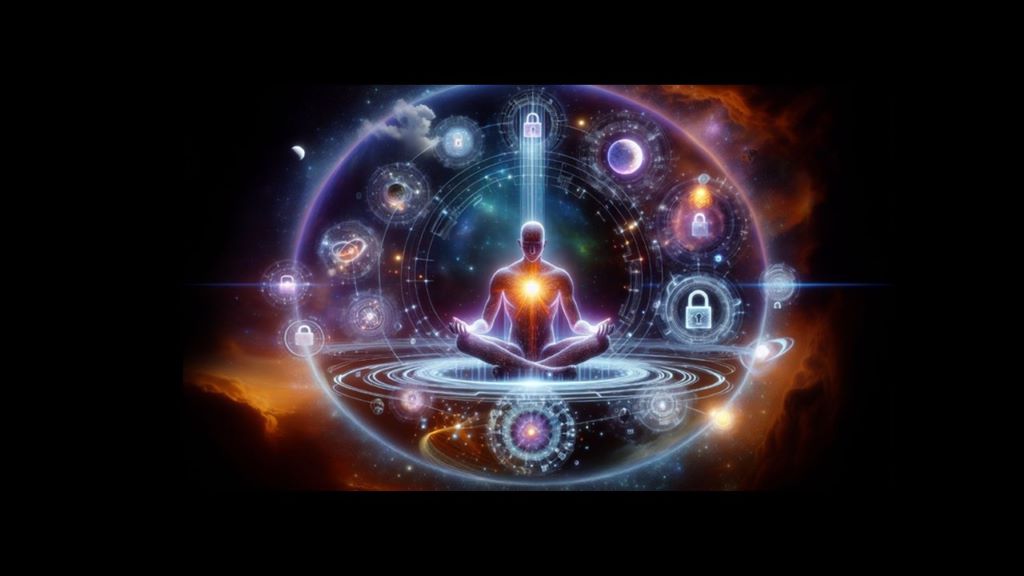 of interior capacities and ways of knowing. Foolish lies begin by shutting down interior forms of knowing and are extrapolated all the way to homo economicus and the belief that the purpose of human life is to propagate a growing economy. We know it is a lie, and we still propagate this game of thrones.
of interior capacities and ways of knowing. Foolish lies begin by shutting down interior forms of knowing and are extrapolated all the way to homo economicus and the belief that the purpose of human life is to propagate a growing economy. We know it is a lie, and we still propagate this game of thrones.
In future installments we will further develop these issues and explore how they stand in the way of liberating your dialogue with your soul and what might be a way to integrate the external and internal perspectives. What becomes evident is that for conventional thinking any conversation about the soul is easily relegated as a) crazy talk, or b) theological dogmatism, or c) primitive unscientific fantasy, endangering humanity by taking us back to the superstitious Middle Ages.
These persuasions are so pervasive and dominant that frankly we stand almost no chance attempting to confront them head-on. Why did I just name these shadows nevertheless?
Because these beliefs and convictions are partly responsible for the unravelling of the modern project through the convergence of a dozen major crises shaping an intractable meta-crisis that’s threatening to undo the world as we have known it and risk human civilization.
In my daily contemplations, I am guided by a sense of love for the unborn souls and spirits who await their planetary opportunity. I imagine them looking back at us from the future, partly with horror, and partly with compassionate love, urging us to wake up from the slumber of our myopic short sightedness and short-term gratification.
You may wonder how the civilization crisis relates to our odyssey into the soul. Our inquiries into the soul are emerging inside the context of this meta-crisis. It would make no sense to venture into this space and the frontiers we are about to enter in the next few chapters except inside the context of integrating the epochal transition underway and the perils of this moment.
Let us return then to the seven-fold orchestration of the soul and prod it on.
A Sevenfold Soul Calibration
In the third installment we seeded a starter appreciation of the seven-fold natures governing all living processes. These seven natures are integral to the soul orchestration. Imagine the soul evaluates, calibrates, and guides you within those natural processes.
Every morning as I get up, I check-in with my soul. I ask how we are doing, which part of my living orchestra needs attention, balancing regulation, and nourishment. I don’t treat myself as one, singular entity. We are each made of many moving parts, each having its rhythms, cycles, and needs. The project of living is bringing our many parts into greater harmony and integration. The soul forever nudges us towards this greater wholeness.
I partner with my soul as she companions me. I listen in to help her do her job, which is to guide my orchestration and navigate my experience in living by being optimally calibrated and connected to my natural and higher purpose.
There are days I feel sharper, more fully attuned, when I respond with great vitality and alignment to the opportunities in front of me. There are other days when I feel that I need to rebalance and regulate the orchestra within, when one part became too dominant or when demands and needs in the environment left me a little weary.
This is the nature of living organisms. We are not machines; we are living beings where the million and more parts that make us are continually recalibrating within these seven-fold natures.
Here is a way to abide with and sense this seven-fold calibration and attunement. Each of the seven natures (corresponding to the seven spectrum colors) work through the soul to offer alignment guidance and orchestration cues. Red nudges you to strengthen your reasons and motivations. Orange nourishes your growth and expands your domains of possibility. Yellow prods you to regather and orchestrate your life and work around a unifying principle, so you are not fragmented but rather an ever-evolving whole person.
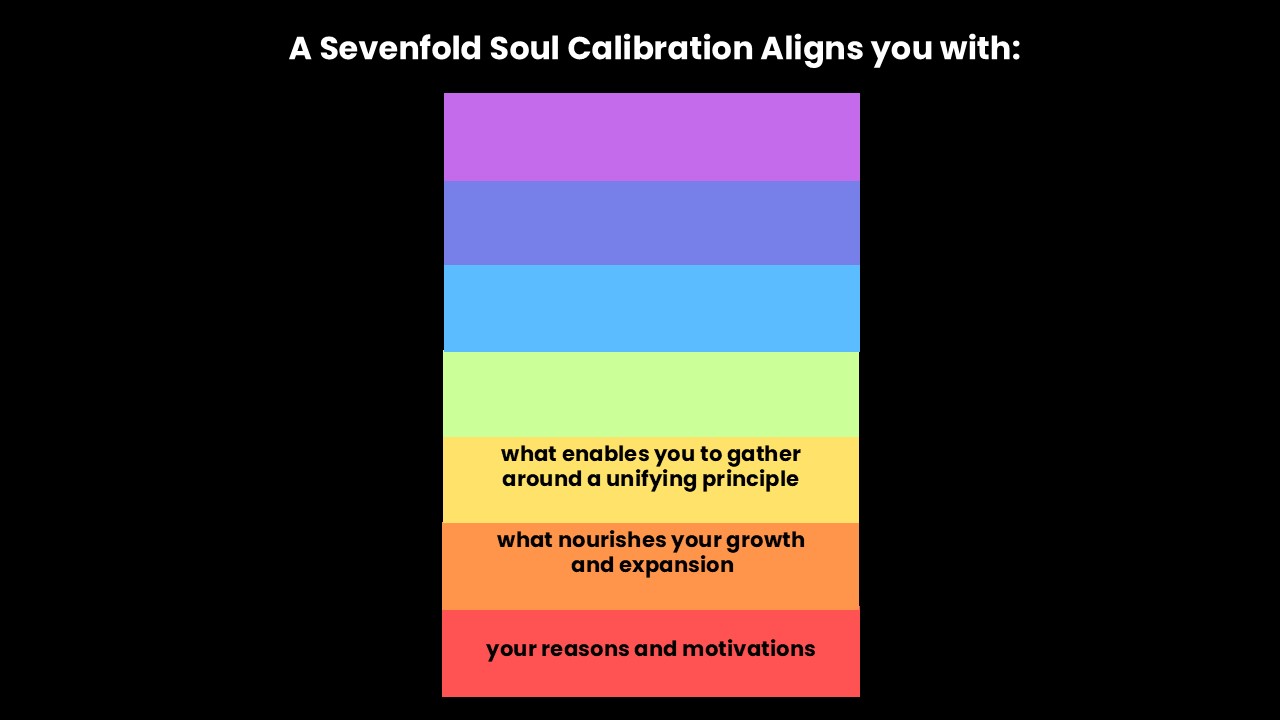
Green is a renewing potency, it helps you heal, absolve, forgive, and rejuvenate. Your soul is like a kaleidoscope of these seven natures forever reconfiguring. It rebalances each potency with the other six as they change and shift roles in leading your orchestra at different times during the day.
Blue guides your management of the environment and the ecologies you create to support your endeavors. It directs you to establish processes and systems to organize and regulate whatever you do.
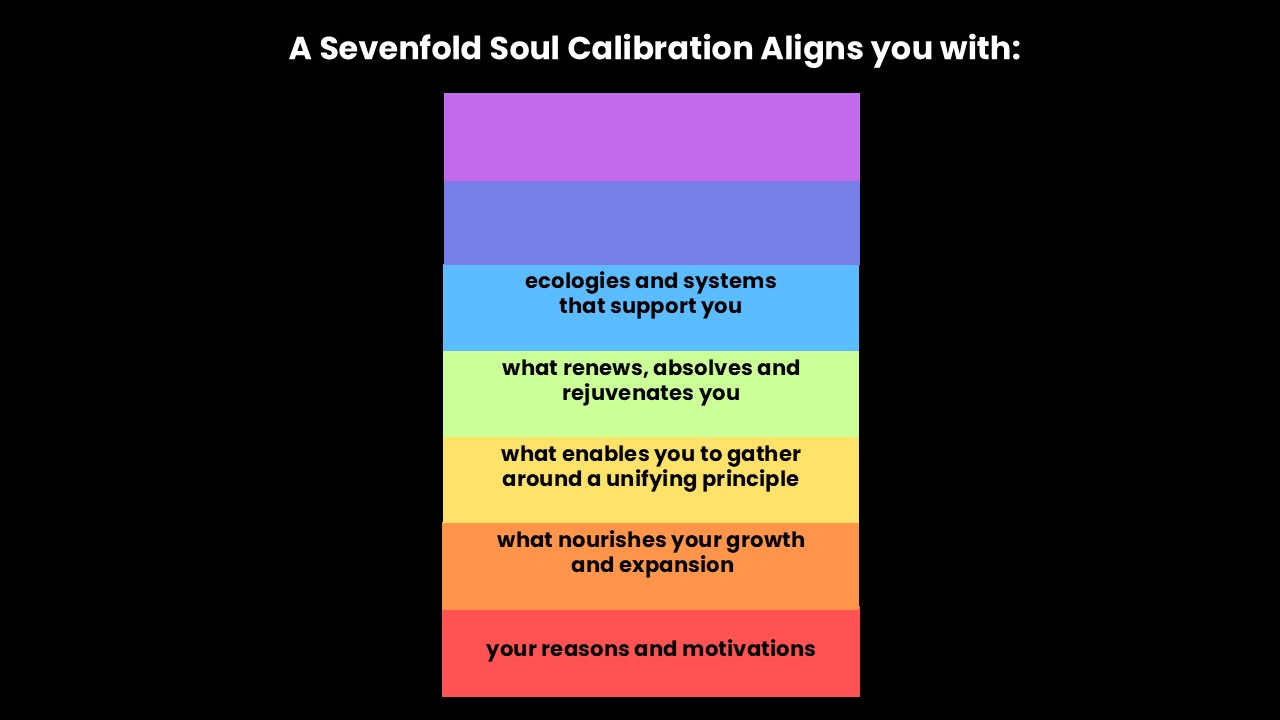
Indigo facilitates new connections. It brings together the merging of all that has previously developed and occurred with what is newly arising, all inside new configurations and possibilities.
Violet is a transformation medium, where octave leaps occur. It is a catalyst of the shift from conclusions to new beginnings, enabling you to emerge transformed and anew.
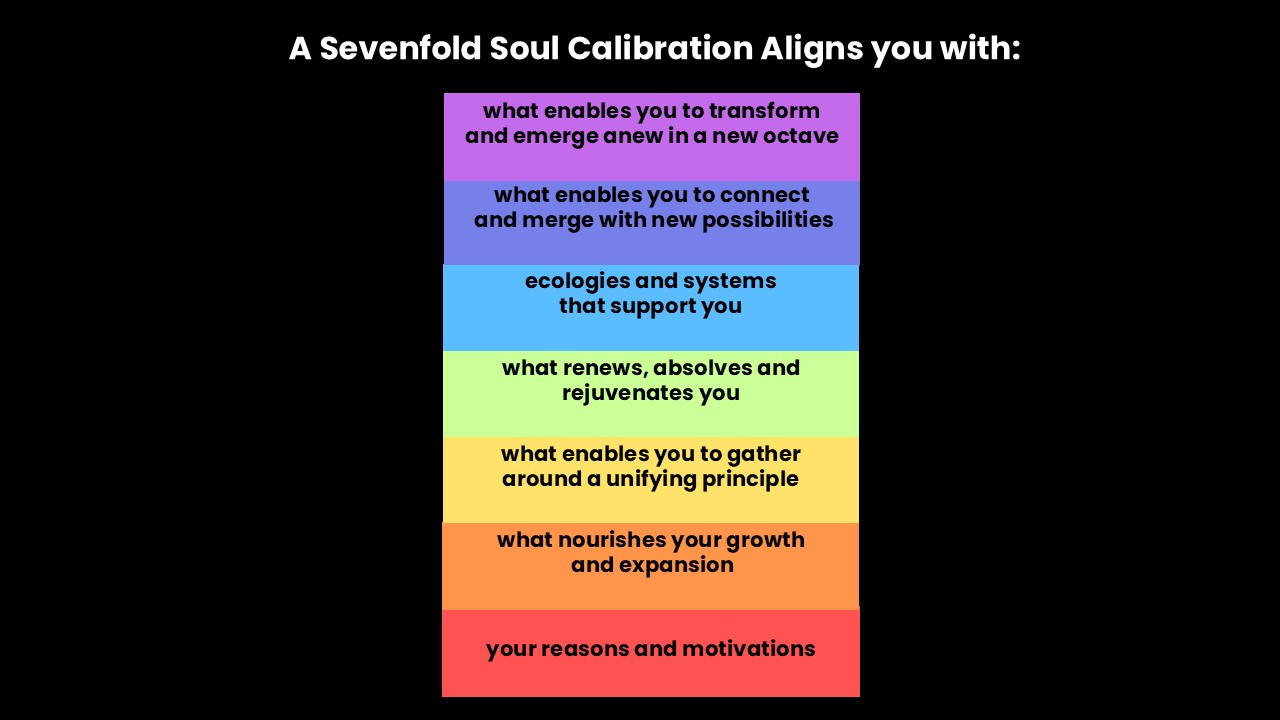
Imagine these seven natures playing through your daily experiences and endeavors, nudging, regulating, and guiding you in the moment to moment of everyday living in everything you do.
I remember, and if I forget, I remind myself, I am never alone. We each always have the companionship of a soul. When we respond from stress and anguish, we tend to create more stress and further downgrade our energy and well-being. When we act with integrity and are well aligned and attuned to the soul and its guidance, we produce an inner glow, vitality, and well-being.
In a later installment we will show how these seven natures play out and express the soul’s guidance, through the three impulses of the soul: The guardian of life, the steward of learning, and the champion of higher purpose.
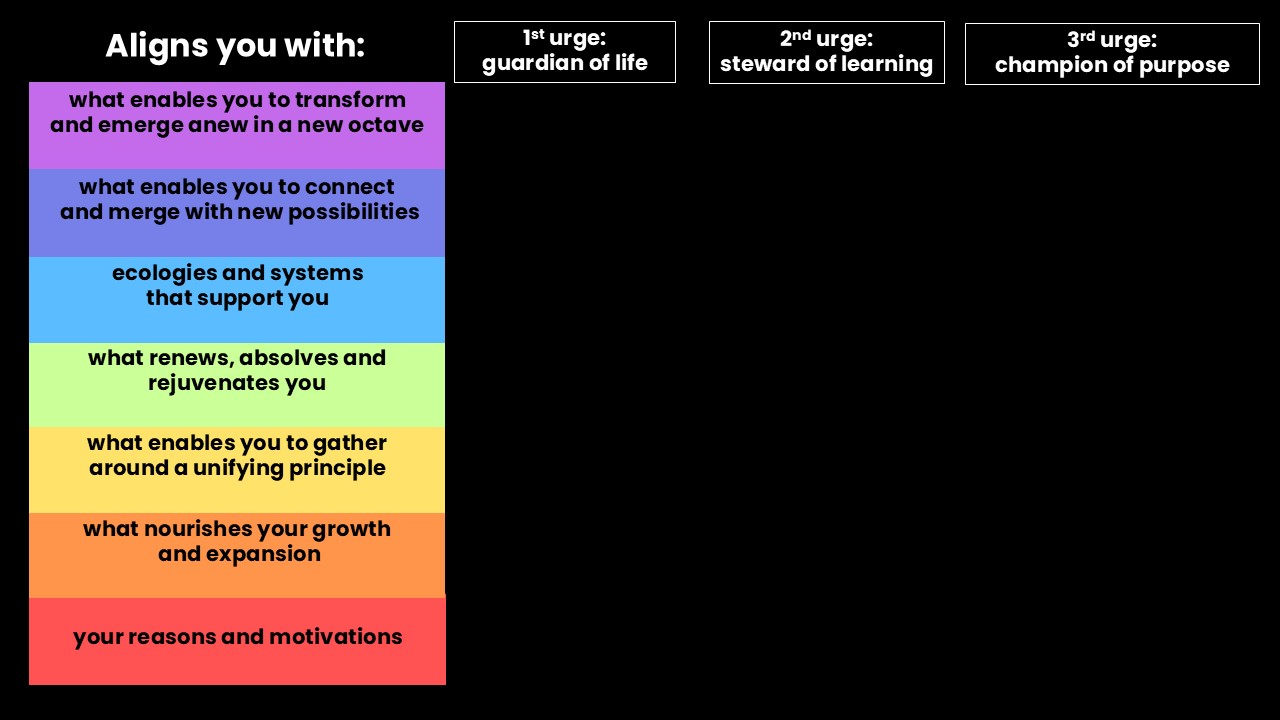
The Next Portal Into the Soul
In this fourth installment we applied loom work to grow and expand conductive space for the soul by weaving new connections. We searched to ease its flow by prodding the liminal space outside of what we think we already know.
To place this soul odyssey in the epoch progression context, we reflected on the post-ideological transition, the grandeur of science and its three main shadows.
We then started to develop the appreciation of the seven natures working through the orchestration of the soul, forever prodding us to become the renewed whole person we are meant to be.
In the next installment our inquiry into the soul will open a side door into a potent practice, which takes the nature of the soul courting the brain.
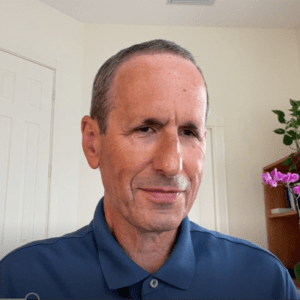
Aviv Shahar
Aviv is the Founder of Aviv Consulting, helping leaders unleash strategic innovation, and is the author of Create New Futures: How Leaders Produce Breakthroughs and Transform the World Through Conversation.
Visit: Aviv Consulting
